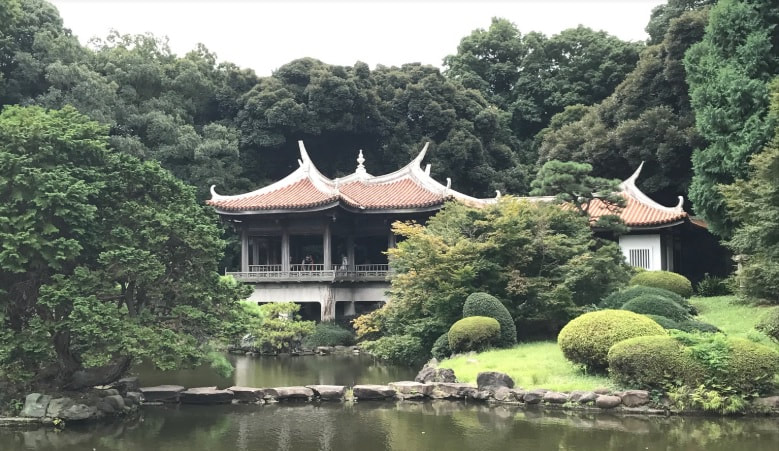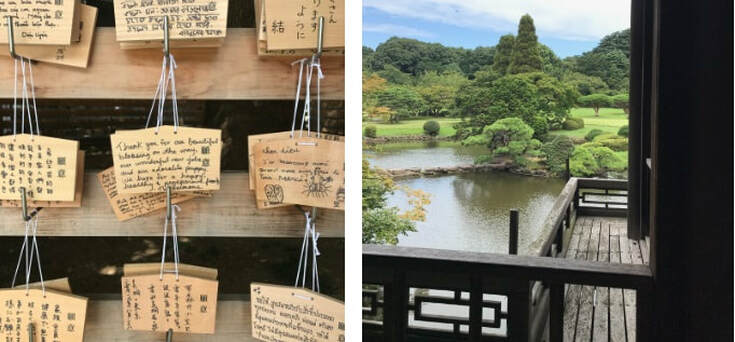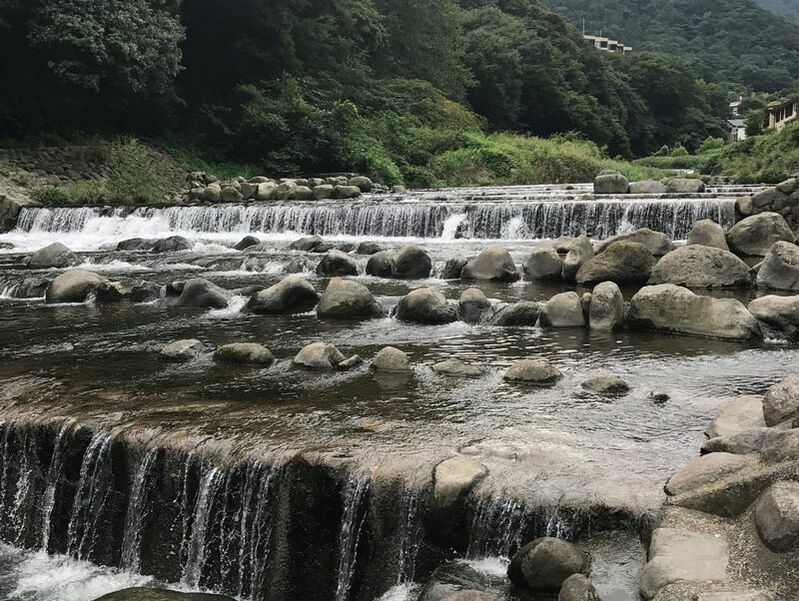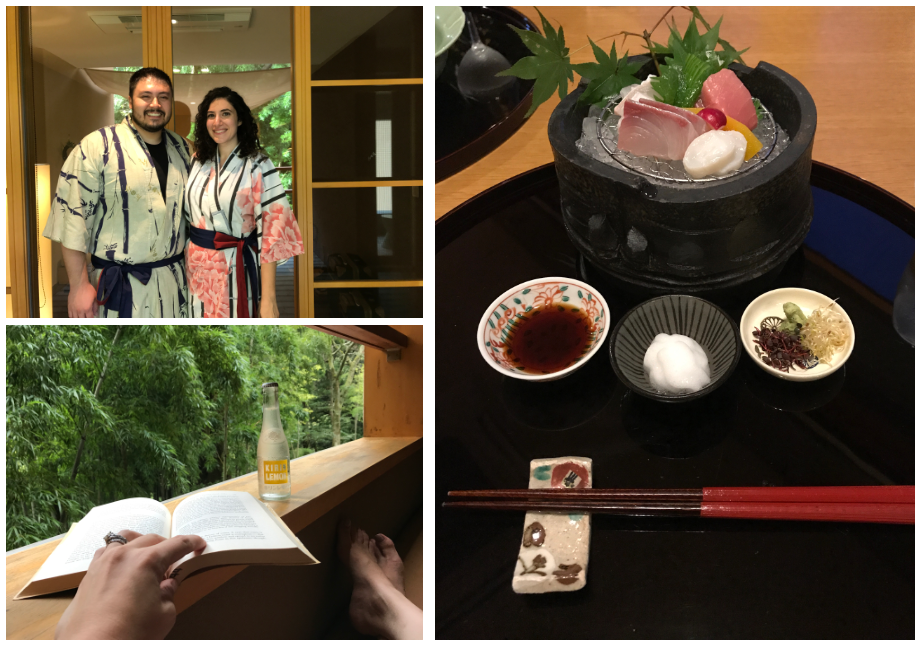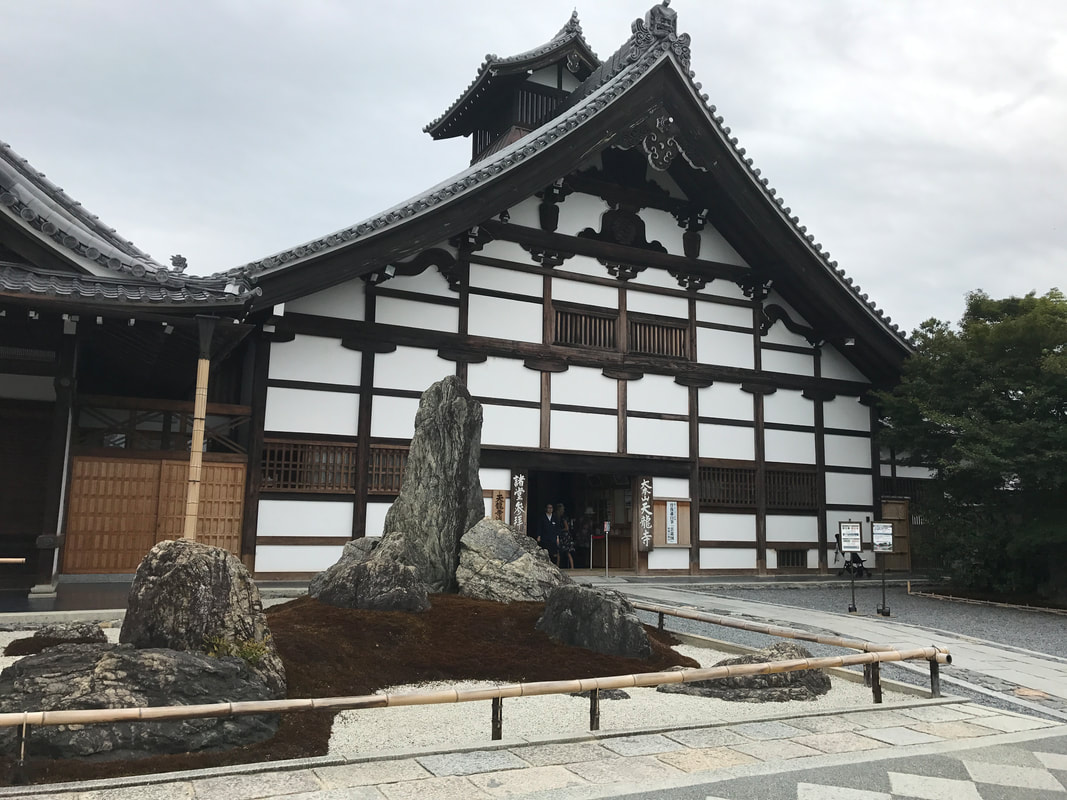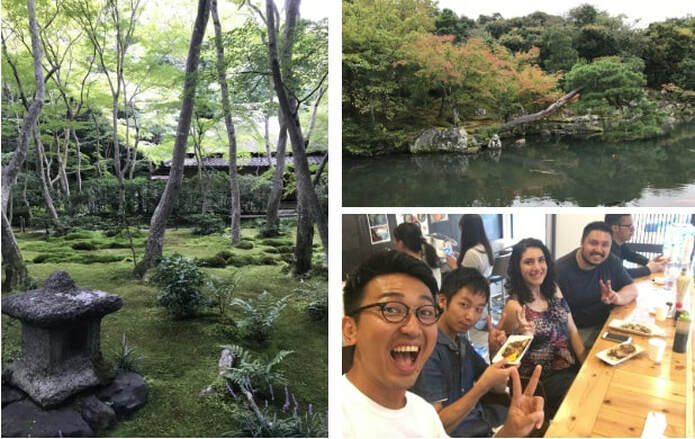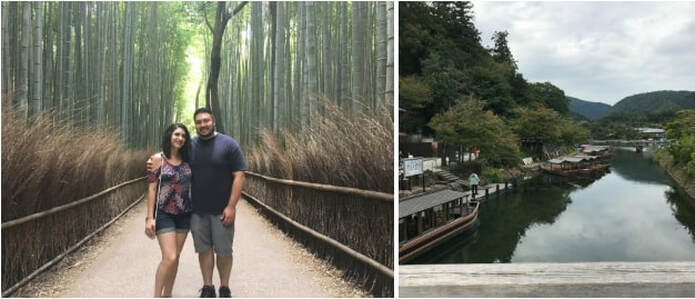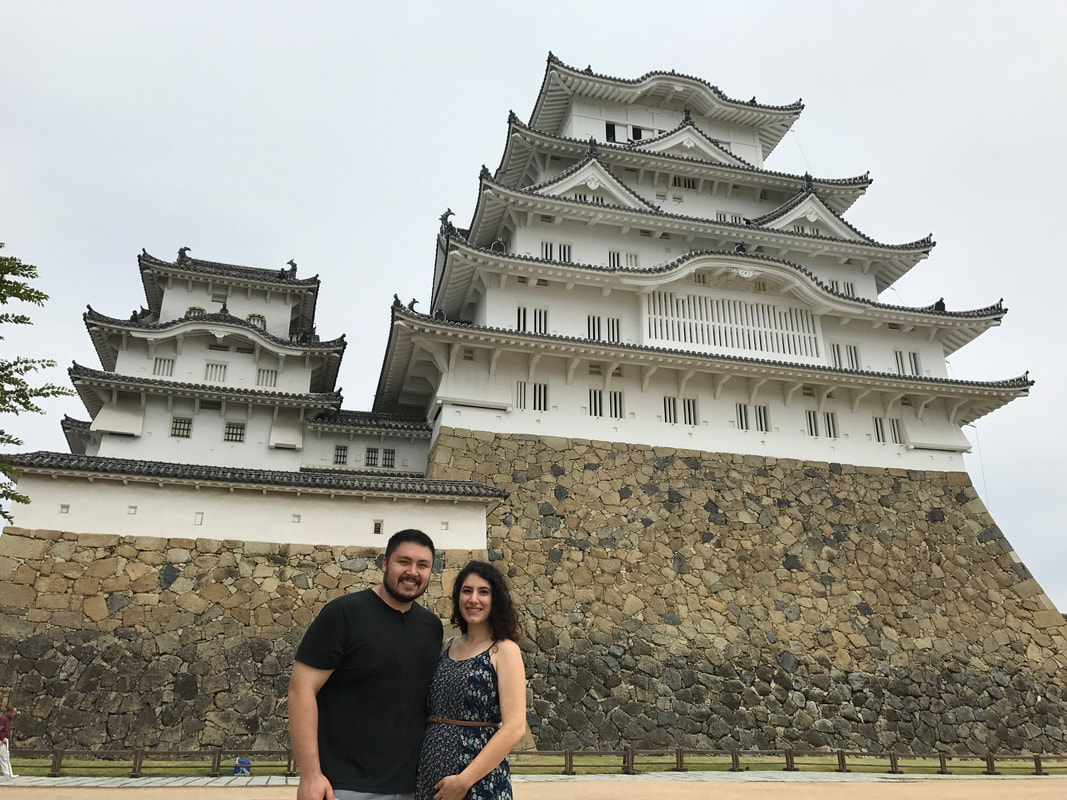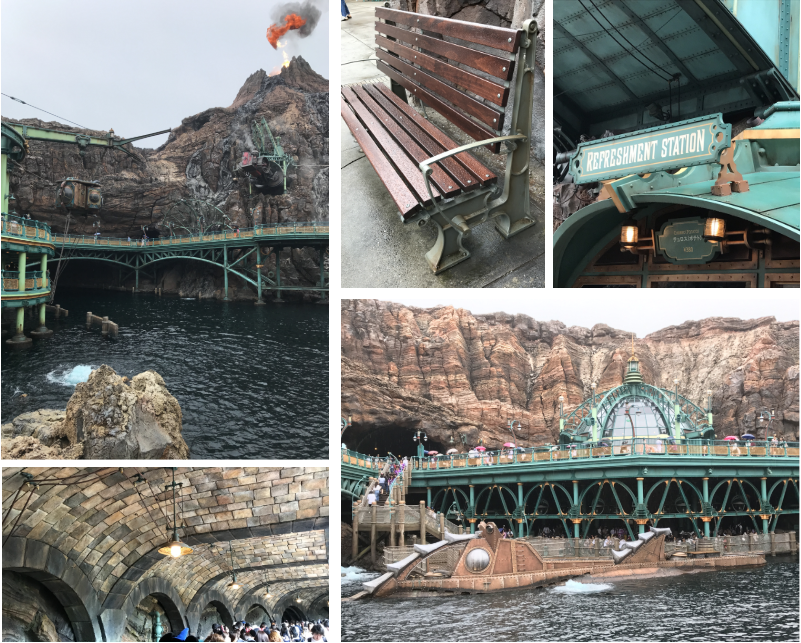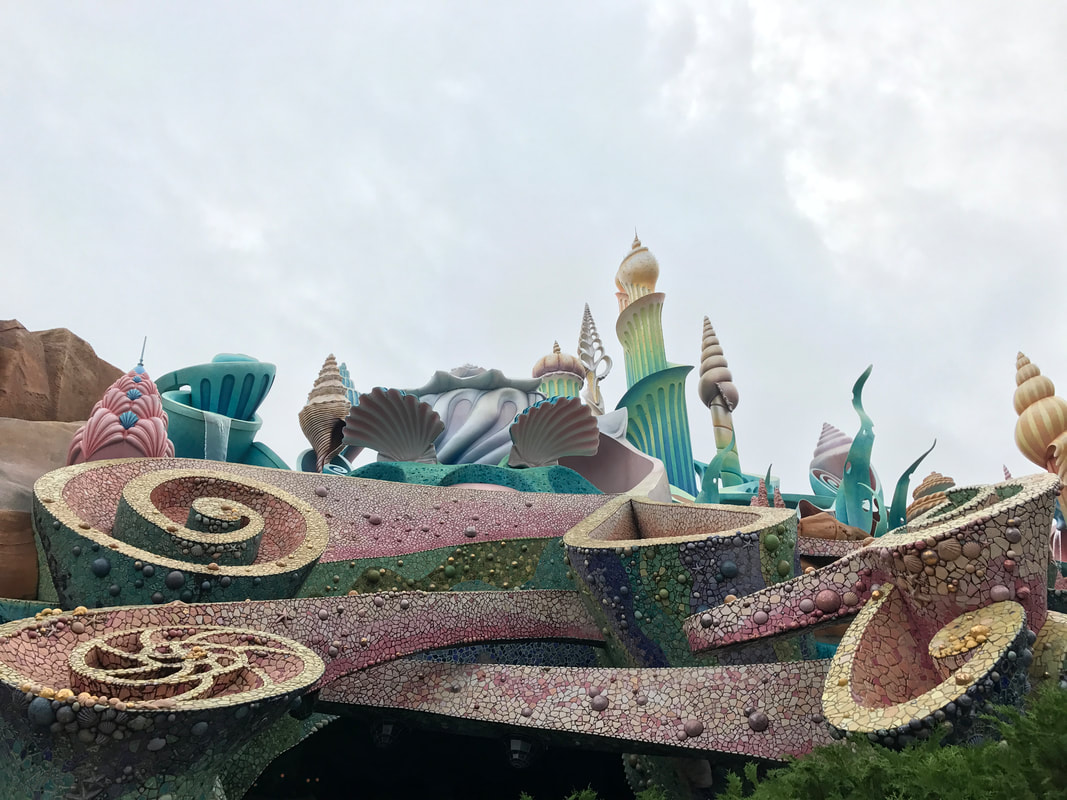Japan in 8 DaysShinjuku Gyoen National Garden In November 2016, my husband and I found a Black Friday flight deal to Tokyo from LAX on Singapore Airlines for under $500 round trip and we couldn't resist. We then had to wait the nine months to our travel day and managed to get pregnant along the way. Luckily for us, Japan is the perfect destination for a babymoon. In recent months, many of my friends, colleagues and acquaintances have been planning their own trips to this amazing country and have asked me for advice on where to go, what to eat and what to do. Japan has been my favorite country to visit so reminiscing about my time there was a special treat. My husband and I spent eight nights in Japan, split between Tokyo, Hakone and Kyoto in September 2017 and loved every minute of it. The following is our itinerary with specific information on the restaurants we enjoyed and the accommodations we stayed in plus tips on what I wish I had known before my trip. Ultimate Japan Itinerary 10 DaysAt a Glance Day 1: Flight to Tokyo Haneda Airport Days 2-4: Explore Tokyo Days 4-5: Hakone onsen ryokan and Mt. Fuji Days 5-9: Kyoto Day 7: Day Trip from Kyoto Day 9: Tokyo DisneySea Day 10: Fly Home Where to Stay in TokyoHotel accommodations in Tokyo were very expensive when my husband and I visited in August 2017 so we had decided to stay in an Airbnb to save money. If I were to take this trip again, I would choose to stay in either Park Hotel Tokyo or Citadines Sinjuku. Both hotels are centrally located in the Shinjuku neighborhood close to a train station, have great traveler reviews and are reasonably priced around $200 a night. In 2017, we paid $100 per night for our studio in Shinjuku compared to $400-$600 hotel rooms at the time but it looks like prices have come down considerably. How to Get around JapanIf there's one thing you should know about getting around Japan, it's that their public transportation system is incredible. We were able to easily take the train from the Tokyo Narita airport to our lodging (though I'd recommend flying into Haneda Airport as it is closer to central Tokyo), walk and take the subway to get around the city and take the shinkansen to Hakone, Kyoto, Himeji and back to Tokyo. It’s all very intuitive and easy. The most important rule to remember when taking public transportation in Tokyo and Japan is that Google Maps is your friend! Just enter your destination and Google Maps will give you step-by-step walking and subway directions to get you there. Most street signs and Metro signs are written in romaji, which is Japanese using English letters, so it is a breeze for English-speakers to navigate. The majority of the time, we were able to walk to where we needed to go and took the subway when we got tired. And if you happen to miss a train, another one will be there in a couple of minutes. If you plan to visit other major cities and want to take the shinkansen speed train, make sure to buy a JR Pass well in advance of your trip as you cannot buy it within the country and need to activate it when you arrive. The JR Pass gives you access to the JR line trains within the city as well as the shinkansen. There is a distinction between the JR lines and Metro. We took the Metro for most of our stay in Tokyo because that’s what went to where we needed to go and we had to buy separate tickets for those trains once we got to the station. If you would like to read more about the different train and subway options, how to buy tickets, how to get around the stations and more, I found this resource on Tripzilla to be useful. One final note: many of the exits and entrances to the subway have A LOT of stairs (as I remember huffing and puffing at 16 weeks pregnant), so keep that in mind if you’re traveling with a stroller. Days 1 and 2: Explore TokyoTokyo is a city of mesmerizing contradiction, the epitome of technology and the quintessence of natural beauty. At no other time is this duality more evident than your first two days. After arriving at the airport, collecting your luggage, taking the train and checking in to your accommodation, kick off the trip right with one of Tokyo's many unique activities. We went to the Robot Restaurant which is permanently closed unfortunately, but you could take a Mario Kart tour or visit a vampire cafe. How about a trip to the Ghibli Museum? Are most of these activities touristy? Yes. Will you be delusionally tired? Of course. Will it all be worth it? You bet. If anything, the quirkiness of Tokyo only gets better the more tired/drugged/drunk you are. None of it makes any sense and you will repeatedly scream, “WHAT IS GOING ON?!” to the Australian tourists next to you and laugh maniacally for two hours straight. You will delight in the ridiculousness of it all. It’s glorious. After your activity of choice, you can get dinner, drink or sleep. The following day is a lot more mellow. If you’re staying in the Shinjuku neighborhood like we did, I would recommend a walking tour of sorts for your second day in Tokyo, starting at the Shinjuku Gyoen National Garden and ending at the Meiji Shrine. While you’re at the garden, you can buy a matcha tea to rest and enjoy your surroundings. Admission into the garden is 500 yen (under $4) per adult and the Meiji Shrine is free if you choose not to purchase a prayer board. Because I was pregnant, we made a point to visit the Mother and Child Forest in the Shinjuku Gyoen National Garden and it was so special. From the garden, you can either make a stop at Shibuya Crossing if you’re up for it or go straight to Meiji Shrine. If you decide to swing by Shibuya Crossing, there are two ways to experience it and I would recommend you try both. First, cross the street as a pedestrian and second, head up to the second floor of the Starbucks for a bird’s eye view of the chaos. For our trip, we saved Shibuya Crossing for another day and instead walked through the residential area and the towering forest that leads to the Meiji Shrine. Make sure to wash your hands and face at the fountain at the entrance before entering. Once inside, you’ll see a section for purchasing souvenirs and prayer boards and across the walkway, you’ll find the shrine. For more details on how to pray at a Shinto shrine, read this article. We loved writing what we are grateful for on the Shinto Prayer Board (Ema) and hanging it up with the others. It was fun seeing the prayer boards in all the different languages swaying in the wind with one another. When you’re looking for a place to eat lunch, the choices of delicious restaurants are plentiful. After visiting the Meiji Shrine, we walked to Fuunji for ramen. You wait in line, order at the vending machine (a regular ramen is more than enough for one person--don’t make the mistake of order a super ramen like we did). With bellies full of noodles and pork, we took the subway back to our room to take a nap before heading out for an amazing tempura dinner at Tsunahachi Shinjuku. 10 things to know about dining in japanQuite a few aspects of Japanese dining surprised me and I wish I had known these at the beginning of my trip rather than toward the end.
day 3: tokyoWhen my husband and I took our trip, our third day in Tokyo was by far the most tiring. Our first stop of the day was the outer Tsukiji Fish Market for a sushi breakfast (we took the subway). While the tuna auctions, inner market and wholesale operations of the market moved to Toyosu in October 2018, the outer market, with all of the wonderful food stalls and sushi joints, is still there for the public to enjoy. We wandered the stalls and stuffed our mouths with mochi filled with custard and topped with strawberry and dipped into a sushi restaurant for my husband to get his fill of his favorite food. They brought me a bowl of miso soup to enjoy with him. For more tips on what and how to eat your way through Tsukiji Market, check out this article. After taking in a feast for the senses, we walked with full bellies to The Imperial Palace East Garden. This was by far the most impressive garden we experienced on our trip and it is well worth the sore calves and aching arches. Admission is free and we spent about two hours exploring the grounds. Even though my legs were dead, I thought it would be a great idea if we walked to Ginza to visit a stationery store called Itoya. Ginza was very fancy, like the Rodeo Drive of Tokyo, but I wouldn’t recommend going out of your way to see it. I would however suggest a stop at Tokyo Tower instead and I wish we had done that ourselves. Itoya was a quick stop and then we took the Ginza Line to have lunch at Tonkatsu Maisen in Aoyama. We were starved and exhausted but I wish we had spent more time in that neighborhood than in Ginza. It’s a trendy part of town with cute boutiques and cafes. There’s a Dominique Ansel bakery, luxury brands and second hand shops. Koffee Mameya has great reviews. Dining at Tonkatsu Maison was one of the most memorable dining experiences we had in Japan. Upon arrival, you wait in line and when you get to the front, they seat you. If you are taken upstairs, it is tatami-style so be prepared to take your shoes off. The extensive menu is divided into cuts of pork and a variety of breeds. For example, you can order the belly of a Japanese black pig nurtured with care by Hayai Okita of the Okita-Kurobuta Ranch. Or the loin of a pig who was raised on a diet of green tea. We absolutely loved the care that went into the husbandry of these pigs and their preparation. It was a beautiful example of the respect Japanese people have for the animals and their land. These cuts of meat were simply prepared and served with rice, cabbage and sauce. It was one of the most delicious meals I’ve ever had and my husband and I still talk about it over six years later. After you’ve had lunch, you can either make your way to Shibuya Crossing if you haven’t visited yet or return to your room to rest. If you still have energy to burn, I'd recommend heading over to Tokyo Skytree. As the world's tallest freestanding tower, Tokyo Skytree boasts a spectacular view of the city. In the evening, take a train or walk to either Daimaru or Isetan Shinjuku for souvenir shopping. Most things were out of our budget when we went, but it was still fun to window shop. For dinner, head down to the department store's depachika (basement food court) which is a food-lover’s delight. The beef fried rice and pork gyoza we tried were exceptional, but you can find any dish you’re craving plus tons of beautiful options for sweets and gifts to take back home. day 4: tokyoYou can still have your “Lost in Translation” moment without shelling out $700 per night to stay at the Park Hyatt Tokyo. Before checking out, head over to the hotel's 41st floor for a lavish breakfast buffet at Girandole restaurant. For a $33 per person splurge--and considering the fact that you’ve been eating breakfast in convenience stores up until now, it’s justifiable--you can enjoy a spread of Western and Japanese dishes with a spectacular view. Please don’t waste your hard-earned dollars on the “Healthy Balance Breakfast” as all of what’s included in this package (and much, much more) is available in the regular buffet. The meal was delicious and it was fun seeing Tokyo from a different perspective. With full bellies, make your way back to your accommodations, pack up your luggage and get yourself to the train station, because you’re going to Hakone! For specific directions on how to get from Tokyo to Hakone, check out this post on the Japan Rail Pass website. The estimated travel time is 2 hours, which includes travel time to and from the train station. Our route was to take the Yamanote Line to Shinagawa Station, then hop on the Tokaido-Sanyo Shinkansen to Odawara Station. We then took the Hakone Tozan bus, which stops at every ryokan on its way up the hill. Depending on which neighborhood you’re staying in Tokyo and which ryokan you're staying in, your route will be different. overnight in HakoneMade famous as the residence of Mt. Fuji, the tallest mountain in Japan, Hakone is a resort town where locals and tourists alike can let down their hair, relax and enjoy nature and the hot springs. Here you’ll find trees--so many trees!--the Haya River, waterfalls and regional delicacies, such as fried seafood dumplings and a huge variety of sweet and savory foods made with bean paste. The train from Tokyo to Hakone will stop in Odawara and from there, you will need to take the bus to your specific onsen ryokan. On our trip in 2017, we stayed at Kinnotake Tonosawa, which we were able to pay for using our Chase Sapphire Reserve points. Otherwise, it would have been over $600 per couple per night (breakfast and use of the hot springs are included, but the traditional kaiseki dinner is an extra charge which you can book once you arrive) at the time of our trip. There are many other wonderful onsen ryokan in Hakone. If I were traveling soon, I'd choose Hakone Ashinoko Hanaori or Hakone Kyuan, both of which have great reviews, include dinner and are much more affordable. what to expect from a stay at an onsen ryokanStaying at a ryokan (a type of traditional Japanese inn that typically features tatami-matted rooms, communal baths, and other public areas where visitors may wear yukata) and enjoying the onsen (hot springs) is a quintessential experience on any trip to Japan. It's definitely not cheap, as these resorts are luxurious, but it's worth the splurge for one night. We arrived at Kinnotake Tonosawa at noon, a bit early for check-in, but the staff welcomed us, took our luggage and guided us to sit on comfortable chairs overlooking the forest. We were presented with menus and got to choose a non-alcoholic beverage and snack. We opted for iced teas and sweet mochi. Since our room wasn’t ready yet, we took the bus back down to the Hakone Yumoto Station to explore the shops, try some local cuisine and enjoy the beautiful nature all around us. Because this shopping area is only half a mile long, you can see it all in a couple of hours, either when you first arrive or before you leave Hakone. As we walked around, we tried different types of cookies, surimi seafood dumplings which I originally thought were made out of potato and sweet adzuki bean buns. It was a great way to hold us over until our kaiseki dinner. We headed back to our resort a little after 3 p.m. to check in and get situated. Back at the hotel, we picked out our yukata (a traditional summer kimono) and were led to our room. Our guide showed us how to wear our yukata and provided us with slippers to wear around the resort. We were then left to enjoy the incredible private hot spring bath on our balcony, big enough for two adults to fit comfortably. After the hustle and bustle of Tokyo, it was so refreshing to unwind, soak our tired feet in the therapeutic waters and take some time to slow down. *An accessibility note about yukata: for those rocking plus-size bodies, you may need to wear a tank top or shorts under your robe when walking around the resort. We found the yukata options to be quite small.* Before we knew it, it was time for dinner. No need to worry about what to wear. It is customary to don your yukata and slippers to the dining room. According to CNN Travel: While kaiseki meals can vary, there are usually some standard courses served and the chef decides the order. These are: Our seasonal menu for the evening included an appetizer of lotus root terrine with pumpkin soup; a simmered dish of Largehead hairtail fish, rolled egg, wax gourd, oyster mushroom and yuzu; a selection of sashimi; Yakimono course of Japanese beef accompanied with an earthenware grill; Hanmono course of eel and steamed rice; Hassun course of grilled eggplant with fig, sesame vinegar and perilla; and dessert of mango ice cream, pudding and white peach. Everything about this meal, from the hospitality to presentation to taste, was impeccable. Following dinner is more relaxation and sleep. You'll awaken to the sound of the river and birds chirping, dress up in your yukata then head back to the dining room for breakfast. For us, breakfast was a combination of Western and Japanese dishes, such as a salad to start, followed by a soup with bread for dipping, then scrambled eggs with a side of fish and potatoes. Breakfast was finished off with fruit. Once breakfast has been thoroughly enjoyed and you’ve packed, it’s time to head back to the Hakone Yumoto Station to start your shinkansen journey to Kyoto. If you didn't get a chance to explore the shops, this is your chance to do so. how to visit mt. Fuji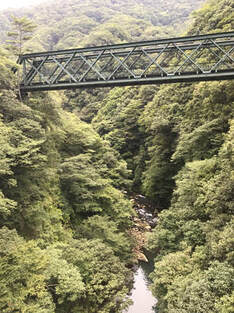 One of the main reasons why I wanted to add a stop in Hakone was to be able to see Mt. Fuji. There is a really cool-sounding circuit of cable cars and gondola to see the mountains. The trouble was that visibility of the mountain is unpredictable. We visited in September, which is tsunami season. The skies were overcast and it rained a lot. There was no visibility of Mt. Fuji that day and we basically wasted a whole day and a lot of money to get only halfway there. It is an expensive and time-consuming journey, one that is probably not worth it for most people. On any given day, the chance of seeing Mt. Fuji is around 20%. If you are okay with the time and financial commitment, have an extra day to dedicate to this adventure and you are going on a sunny day/season, then it might make sense. Otherwise, I would highly recommend skipping a sojourn to Mt. Fuji and make your way straight to Kyoto from Hakone. To learn more about visiting Mt. Fuji, check out this article from Go with Guide. Day 5: KyotoIf all goes well and you've arrived at the Kyoto train station around 2 p.m. from Hakone, head to your lodging and check-in. To get to Kyoto from your ryokan in Hakone, you'll need to get yourself back to Odawara station, then hop on the Tokaido-Sanyo shinkansen to Kyoto Station. For our stay in Kyoto, we booked a room at the Hotel Granvia which is adjacent to the station (or right above it? I never could figure it out). I loved staying here because it's easy to get to from the train (and I knew we would be hopping on and off the train a lot in the next three days), there are great restaurants both inside the hotel and within walking distance, and it was affordable. Once you've checked in, take a bus to eat at any of the restaurants on this Inside Kyoto list of best restaurants and spend the evening leisurely wandering around wherever you decide to have dinner. I would recommend eating gyoza at Chaochao Sanjo-Kiyamachi or tempura at Tendon Makino Kyoto then taking a stroll across the river to the Gion neighborhood. This is the perfect opportunity to explore the plethora of shops along Shijo Dori to find souvenirs. If you're traveling in July, be sure to stop by the Yasaka Shrine for the Gion Matsuri festival, the most famous festival in all of Japan, to experience the float processions and food stands. Depending on the time, you can also make your way to Kiyomizu-dera Temple--usually it closes at 6 p.m. but on certain days in spring, summer and fall, the temple stays open until 9 p.m. for illumination. Our first night in Kyoto looked much different than this. We stumbled into our hotel room close to 8 p.m., starving, and headed upstairs to the on-site restaurant. There, we enjoyed an incredible view of the city and a pumpkin soup so delicious, I still daydream about it. The soup actually came as part of my husband's meal and I asked them for my own bowl. That's how good it was. Then we slept. day 6: explore kyotoOne of the most beautiful and culturally rich parts of Kyoto is the Arashiyama neighborhood. This is where you'll find the famed bamboo grove, the Tenryuji Temple, and other wonderful food and natural experiences. The best way to experience most of it is with a food tour of the area with Japan Wonder Travel. Our guide met us at the train station and led us through the town to a variety of food stalls, shrines, temples and restaurants, answered all of our questions and gave us insider tips on where to eat and what to see in the rest of Kyoto. I don't want to give away too many details of where we went because my description won't give the day justice--suffice it to say that I think everyone who wants an authentic experience with a local should book this tour. If you have time and energy after your tour, make the trek up the hill to the Arashiyama Monkey Park Iwatayama. This was on my list of places I wanted to see on our trip, but I didn't have energy leftover in my pregnant state to make it. Our food tour of Arashiyama ended around 3 p.m. and because the bites are small and I was always hungry, by the time we took the bus back toward our hotel, I wanted dinner. We walked from the Karasuma Gojo bus stop to Ginjo Ramen Kubota which came highly recommended by our tour guide. To order food, you simply wait in line, place your order on the vending machine and give your ticket to one of the chefs when you sit down. The broth of this ramen was almost like gravy, rich and flavorful, tasting as though it had been simmering for hours. It was the best ramen we had in Japan. You can spend the rest of the night doing whatever you choose, whether that's bar hopping, exploring Nishiki Market, or sleeping. I'm sure you can guess what we did. Sleep. day 7: day trip from kyotoBy this point in your trip, you will have explored the shrines and temples and have eaten all the food, making this the perfect launching point for a day trip (or overnight trip depending on how much extra time you have and how far you'd like to go). On our third day, we ate breakfast at the buffet in our hotel, which was amazing by the way, then took a 45-minute train to Himeji Castle and were able to get back to Kyoto by dinner time. One of my coworkers, who had 10 days in Japan, fit in an overnight trip to Hiroshima, which is definitely doable because the fastest shinkansen train ride is less than two hours. If you want to go this route, I would recommend checking out of your hotel, heading to Hiroshima in the morning, staying the night then returning to Kyoto the next day. Here is a sample itinerary for a day trip to Hiroshima. There are so many options for day trips based on your personal interests. Check out this article on JR Pass's website for a selection of day trips. On our last night in Kyoto, we ate gyoza and went souvenir shopping on Shijo Dori (my recommended itinerary for the first night). If you already did this, take your time to explore a different part of the city or check other items off of your bucket list. If you have the time and energy, make sure you stop by Fushimi Inari Taisha before leaving Kyoto. We were planning on visiting this shrine the morning of our eighth day, but wanted to save our energy. Not seeing those famous torii gates is one of my two regrets of this trip, the other one being not going to the monkey park. We're planning a return trip to do everything we missed the last time we were in Kyoto. Day 8: Kyoto to disneyseaThe last day of our eight day, eight night trip to Japan was by far my favorite because we went to Tokyo DisneySea! We skipped on the Fushimi Inari Taisha to save our energy for Disney because I was pregnant and easily exhausted. If you have 10 days to spend in Japan, I'd recommend spending an extra night in Kyoto or at least most of day eight to visit the shrine. Then take the train to Tokyo DisneySea in the afternoon and give yourself a full day at DisneySea on day nine before heading home on day ten. Because we had only eight days in Japan, this is what we did. Around 8 a.m., we filled up on our hotel's breakfast buffet in Kyoto, checked out and headed down to the train station to take the Tokaido-Sanyo shinkansen to Tokyo and the Keiyo line to Mahaima Station, a trip that took about 3 hours. For an incredibly seamless and easy check-in and theme park experience, book a hotel room that's located along the monorail. We stayed at the Sheraton Grande Tokyo Bay Hotel because it has good reviews and it was affordable compared to the other options. Be forewarned though that the beds are quite small; my husband and I had to sleep on separate beds because we couldn't fit on one together. Having a whole bed to yourself is not the worst problem to have. In the years since we visited, it looks like the Grand Nikko Tokyo Bay has received better reviews and the price is comparable between the two hotels. Upon arriving at the Mahaima Station, you walk with your luggage to an area where all of the hotels in Tokyo Bay have check-in services. Here, you can check-in to your hotel, receive your room number and keys, leave your bags to be taken to your room and head straight to the park. This totally blew my mind! I was planning on spending an extra hour at the very least going to the hotel, leaving our bags there then going back to the park entrance. But this setup was so unexpectedly wonderful. From the get-go, Tokyo Disney wants to make sure you have a pleasant experience. Now, you may be debating whether to go to Tokyo Disneyland or DisneySea or you might think it's not worth your time at all. Let me stop you right there--Tokyo DisneySea was one of the most incredible experiences of my life and YOU NEED TO GO. It's a totally unique park with attractions you won't find at any other Disney Park in the world and it's where Imagineers go to have their wildest ideas realized. Even if you don't care about Disney, or perhaps especially if you don't care about Disney, this park is for you. Everything about it is so perfect and beautiful. The attention-to-detail in the decor is on another level; even the benches fit the theme of whatever world you're in. The food is affordable and delicious. My husband got a three course lunch with salad, chicken cacciatore with squid ink risotto and dessert plus a drink for $12. All snacks are between $2-4. It's not crowded. The rides are in Japanese which is especially fun if you've ever wanted to be yelled at in Japanese by the Finding Nemo crew in 3D. They have the best merchandise. Everyone who goes together wears matching outfits and it's so heartwarming. HAVE I CONVINCED YOU?! If you need a little more convincing, read this article about 10 Reasons Why Tokyo DisneySea is the Best Theme Park. Check out all the incredible foodstuffs you can put into your mouth hole. These are all the reasons why Tokyo DisneySea is the best park. I am obsessed with it and can't wait to go back and you need to go too if you're going to Tokyo. THE END. THANK YOU AND GOODBYE.
1 Comment
|
